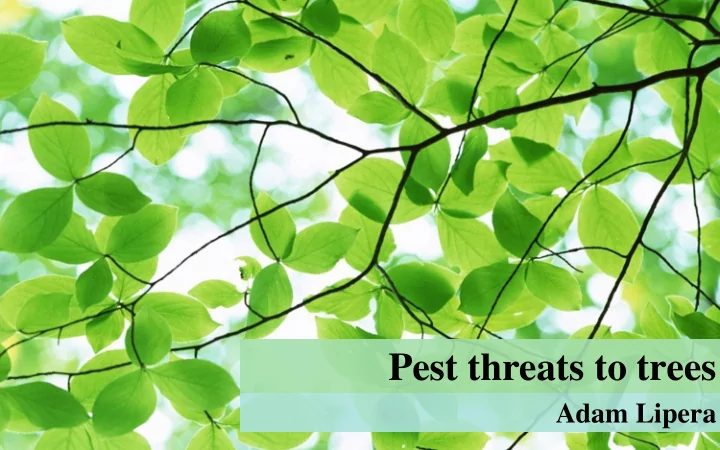

Pest threats to trees Adam Lipera
Gypsy Moth • Caterpillar causes most of the damage (physical) • Affected trees: oaks, aspen, apple, sweetgum, alder, linden, birch, poplar, willow, and hawthorn • Last treatment: May 2008, with no recent outbreaks
Emerald Ash Borer • Grub causes most of the damage (physical) • Affected trees: ash • Last treatment: ongoing, with injection treatments on Champion trees and large street trees every two years • Virginia is currently under quarantine
Dutch Elm Disease • Spread by elm bark beetles • Affected trees: elm, zelkova • First sign of infection is typically upper branches displaying leaves starting to wither and yellow in summer, months before the normal autumnal leaf shedding • Last treatment: ongoing, with injection treatment of Oakland Park elm every two years
Asian Longhorned Beetle • Grub causes most of the damage (physical) • Affected trees: maple, poplar, elm, willow • Has not been sighted in Arlington County, however, due to the wide Asian Longhorned Beetle range of species affected, this is a high threat
Walnut twig beetle • Carries Thousand Canker Disease • Affected trees: walnut • Monitored for evidence, but no walnuts showed signs of infection
Dogwood Anthracnose • Fungus causes dieback or death of infected trees • Early symptoms begin in mid to late May as leaf spots with tan or purple borders • Affected trees: dogwood
Tree Scale • Scale infestations weaken the host tree, and if the infestation is severe enough the tree can die • Damage includes: branches covered with small bumps (the bumps are actually the insects), yellow or brownish leaves, premature leaf drop, twig or branch dieback, slower growth, excess secretion of sap/ honeydew
Spotted Lanternfly • Not a fly, more of a hopper/jumper • Feeds on woody and non-woody plants by piercing the tissue of foliage and young stems and sucking the sap • Host list in Virginia: tree of heaven, cherry, locust, maple, elm, Virginia creeper, white pine, wild grape, table grape, hackberry, poison ivy, multiflora rose, mulberry, sumac, walnut, English ivy, bush honeysuckle, Japanese honeysuckle, crab apple, boxelder • Banding and monitoring by Arlington County to be done this year (Spring 2019)
Recommend
More recommend